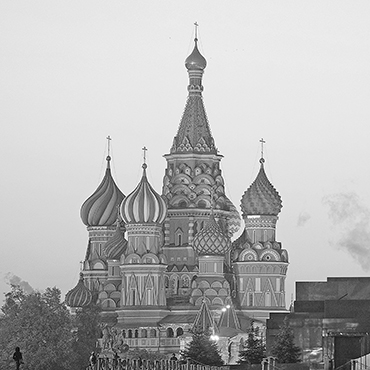CRACKS IN THE KREMLIN CONSENSUS
While Vladimir Putin's war effort is deeply unpopular in the West, and increasingly among ordinary Russians in the wake of his September mobilization order, whether the Russian President's inner circle back his campaign has long been an open question. Until now. According to assessments by U.S. intelligence, discontent over Russia's staggering losses in Ukraine to date is finally reaching Putin's ears, as his advisors and confidantes become increasingly divided over the course – and costs – of the conflict. Instances of infighting among Russian military officials, as well as condemnations from Putin loyalists like Chechen strongman Ramzan Kadyrov (who has complained publicly of military ineptitude on social media), have been visible for weeks. But now, U.S. intelligence services say, one of Putin's closest confidantes has "voiced disagreement directly to the Russian president in recent weeks over his handling of the war in Ukraine."
The news belies a larger trend. "Since the start of the occupation we have witnessed growing alarm from a number of Putin's inner circle," a Western intelligence official has told the Washington Post. "Our assessments suggest they are particularly exercised by recent Russian losses, misguided direction and extensive military shortcomings." (Washington Post, October 7, 2022)
WESTERN TECH STILL FUELS PUTIN'S WAR MACHINE
Officials in Ukraine have long known that one of the deciding factors in their struggle against Russia will be Russia's ability to procure high-tech parts for its war effort. The lack of such components has led to a marked decline in Russian military performance in recent weeks. But while Western nations have barred exports of advanced electronic chips (the foundation of most modern weapons) to Russia since the start of the war, Russian weapons have been found to still contain such Western components. A recent report to the UN by Statewatch NGO, the Economic and Security Council of Ukraine, and B4Ukraine notes that materiel recently captured by Ukrainian soldiers is still "found to rely predominantly on Western components, and of these, about two-thirds of the parts were manufactured by U.S.-based companies."
Following the outbreak of the war in February, the U.S., along with other key chip manufacturing countries, imposed strict bans on the export of sensitive components to the Russian military, as well as items that could be considered "dual-use." However, Russia is adapting, and has found ways to secure Western microchips depite the bans. For instance, the report notes, "[m]any components are sold through distributors operating in Asia, such as Hong Kong, which acts as a gateway for electronics making their way to the Russian military or companies acting on its behalf... Meanwhile, in March, the US government said that Russian front companies had been buying up electronics for Russia's military, with the RUSI [the UK's Royal United Services Institute] finding one company that imported $600,000 worth of electronics manufactured by Texas Instruments through a Hong Kong distributor." (Investment Monitor, October 13, 2022)
IRAN AND THE RUSSIAN WAR EFFORT
For decades, Russia and the Islamic Republic have shared a deep strategic partnership, with the Kremlin running interference for Iran at multilateral forums like the United Nations and helping dilute the impact of international sanctions levied against the Iranian regime. Since the start of Russia's war in Ukraine, however, the traditional partnership between Moscow and Tehran has been reversed, with Iran emerging as a major source of military materiel for Russia's armed forces. Tehran, for instance, has supplied helmets and bulletproof vests to help outfit Russian soldiers being sent to the front lines. More significantly, the Iranian regime has made multiple shipments of indigenously-made drones to the Russian military, as well as deploying military trainers to Crimea to assist Russian servicemen in operating them properly. Iran's assistance, in turn, has allowed the Kremlin to expand its offensive against Ukraine still further. In recent days, Iranian UAVs have been used by the Russian military as "kamikaze drones" to target Ukrainian cities and civilian population centers, as well as troop emplacements. (NBC News, October 17, 2022; New York Times, October 18, 2022; Kyiv Independent, October 24, 2022)
[EDITORS' NOTE: The development is deeply significant. It indicates a substantial shift in the nature of the Russo-Iranian relationship, and also carries potentially momentous consequences for Tehran. Russia's intentional targeting of civilians and civilian infrastructure in Ukraine represents a violation of the laws of war, and Iran's active assistance to this effort makes the Islamic Republic potentially complicit in Russian war crimes.]
PUTIN CONSOLIDATES POWER OVER MOSCOW-CLAIMED TERRITORIES
In an effort to solidify control over recently acquired territories in the face of Western opposition and gains by the Ukrainian armed forces, the Kremlin is instituting martial law on land that it has annexed. The regulation, which applies in Donetsk, Luhansk, Zaporizhzhia and Kherson (where the Kremlin recently carried out stage-managed referendums that were roundly rejected by the West) "gives authorities sweeping powers to impose curfews, travel and residence restrictions, military censorship, and more," according to The Moscow Times. But the Russian government is also instituting extra security measures elsewhere, and has called on the cities of Krasnodar, Belgorod, Bryansk, Voronezh, Kursk, Rostov, and Crimean oblasts to "increase their security, implement a special entry regime and limit the movement of vehicles over their borders" in anticipation of potential Ukrainian penetration or sabotage. (The Moscow Times, October 19, 2022)
Want these sent to your inbox?
Subscribe

